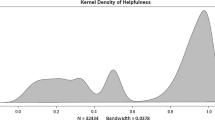Abstract
Recently, many e-commerce Web sites, such as Amazon.com, provide platforms for users to review products and share their opinions, in order to help consumers make their best purchase decisions. However, the quality and the level of helpfulness of different product reviews are not disclosed to consumers unless they carefully analyze an immense number of lengthy reviews. Considering the large amount of available online product reviews, this is an impossible task for any consumer. Therefore, it is of vital importance to develop recommender systems that can evaluate online product reviews effectively to recommend the most useful ones to consumers. This paper proposes an information gain-based model to predict the helpfulness of online product reviews, with the aim of suggesting the most suitable products and vendors to consumers. Reviews are analyzed and ranked by our scoring model and reviews that help consumers better than others will be found. In addition, we also compare our model with several machine learning algorithms. Our experimental results show that our approach is effective in ranking and classifying online product reviews.
Similar content being viewed by others
References
Anagnostopoulos A, Broder AZ, Punera K (2008) Effective and efficient classification on a search-engine model. Knowl Inf Syst 16(2): 129–154
Balabanovic M (1997) An adaptive web page recommendation service. In: Proceedings of the first international conference on autonomous agents, pp 378–385
Euzenat J (2007) Semantic precision and recall for ontology alignment evaluation. In: Proceedings of the 2007 international joint conference on artificial intelligence, pp 348–353
Goldberg D, Nichols D, Oki BM, Terry D (1992) Using collaborative filtering to weave an information tapestry. Commun ACM 35(12): 61–70
Hatzivassiloglou V, McKeown KR (1997) Predicting the semantic orientation of adjectives. In: Proceedings of the eighth conference on European chapter of the association for computational linguistics, pp 174–181
Hu M, Liu B (2004) Mining and summarizing customer reviews. In: Proceedings of the tenth ACM international conference on knowledge discovery and data mining, pp 168–177
Hu N, Liu L, Zhang J (2008) Do online reviews affect product sales? The role of reviewer characteristics and temporal effects. Inf Technol Manag
Inui K, Abe S, Hara K, Morita H, Sao C, Eguchi M, Sumida A, Murakami K, Matsuyoshi S (2008) Experience mining: building a large-scale database of personal experiences and opinions from Web documents. In: Proceedings of the 2008 IEEE/WIC/ACM international conference on web intelligence and intelligent agent technology, pp 314–321
Kim SM, Pantel P, Chklovski T, Pennacchiotti M (2006) Automatically assessing review helpfulness. In: Proceedings of the 2006 Conference on empirical methods in natural language processing, pp 423–430
Lee C, Lee GG (2006) Information gain and divergence-based feature selection for machine learning-based text categorization. Inform Process Manag 42
Pang B, Lee L, Vaithyanathan S (2002) Thumbs up?: sentiment classification using machine learning techniques. In: Proceedings of the ACL-02 conference on empirical methods in natural language processing, pp 79–86
Park DH, Lee J, Han I (2007) The effect of on-line consumer reviews on consumer purchasing intention: the moderating role of involvement. Int J Electron Commerce 11(4): 125–148
Pollach I (2006) Electronic word of mouth: a genre analysis of product reviews on consumer opinion web sites. HICSS 3: 1530–1605
Resnick P, Iacovou N, Suchak M, Bergstrom P, Riedl J (1994) GroupLens: an open architecture for collaborative filtering of netnews. In: Proceedings of the 1994 ACM conference on computer supported cooperative work, pp 175–186
Sarwar BM, Karypis G, Konstan JA, Reidl J (2001) Item-based collaborative filtering recommendation algorithms. World Wide Web pp 285–295
Shannon CE (2001) A mathematical theory of communication. SIGMOBILE Mob Comput Commun Rev 5(1): 3–55
Turney P (2002) Thumbs up or thumbs down? semantic orientation applied to unsupervised classification of reviews. In: Proceedings of the 40th annual meeting of the association for computational linguistics (ACL), pp 417–424
Weimer M, Gurevych I, Mühlhäuser M (2007) Automatically assessing the post quality in online discussions on software. In: Proceedings of the 45th annual meeting of the association for computational linguistics, pp 125–128
Weimer M, Gurevych I (2007) Predicting the perceived quality of web forum posts. In: Proceedings of the conference on recent advances in natural language processing
Wong T, Lam W (2008) Learning to extract and summarize hot item features from multiple auction web sites. Knowl Inf Syst 14(2): 143–160
Wu X, Kumar V, Quinlan J, Ghosh J, Yang Q, Motoda H, McLachlan GJ, Ng A, Liu B, Yu PS, Zhou Z, Steinbach M, Hand DJ, Steinberg D (2008) Top 10 algorithms in data mining. Knowl Inf Syst 14(1): 1–37
Yang Y, Pedersen JO (1997) A comparative study on feature selection in text categorization. In: Proceedings of the fourteenth international conference on machine learning, pp 412–420
Yu H, Hatzivassiloglou V (2003) Toward answering opinion questions: separating facts from opinions and identifying the polarity of opinion sentences. In: Proceedings of the 2003 conference on empirical methods in natural language processing, pp 129–136
Zhuang L, Jing F, Zhu XY (2006) Movie review mining and summarization. In: Proceedings of the 15th ACM international conference on information and knowledge management, pp 43–50
Author information
Authors and Affiliations
Corresponding author
Rights and permissions
About this article
Cite this article
Zhang, R., Tran, T. An information gain-based approach for recommending useful product reviews. Knowl Inf Syst 26, 419–434 (2011). https://doi.org/10.1007/s10115-010-0287-y
Received:
Revised:
Accepted:
Published:
Issue Date:
DOI: https://doi.org/10.1007/s10115-010-0287-y




